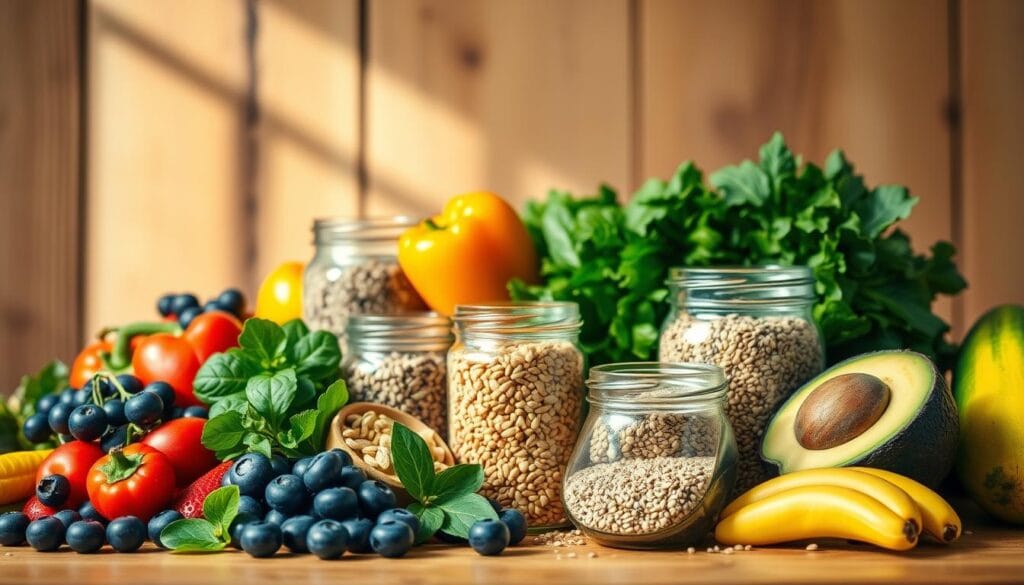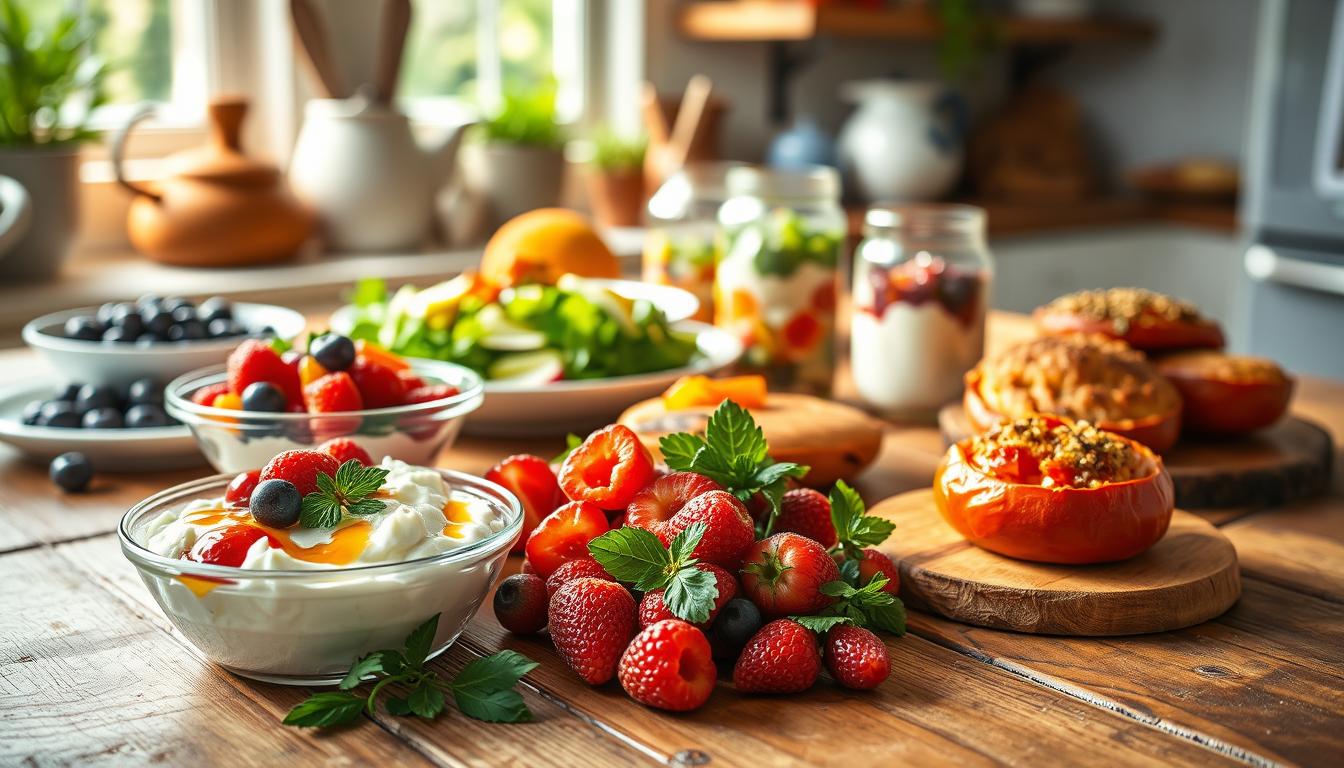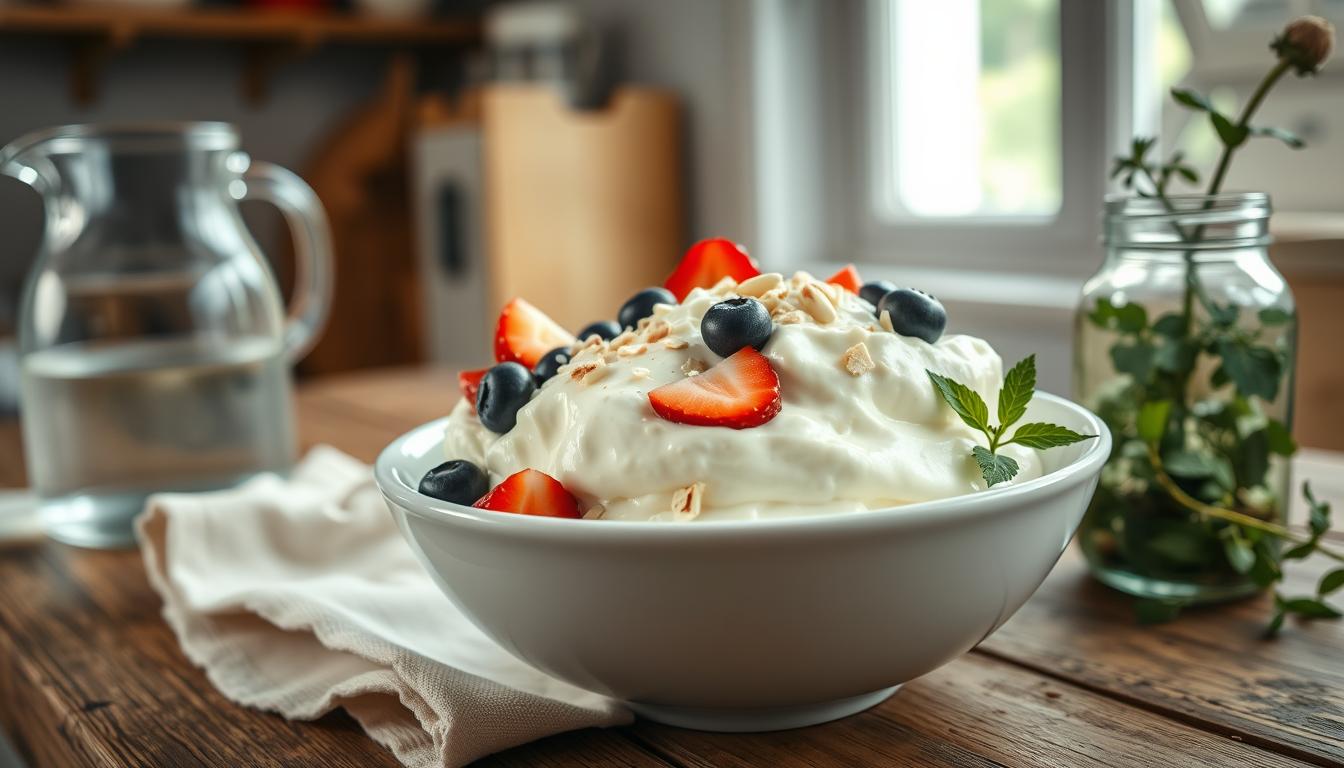Managing blood sugar with a low glycemic vegan diet is a new way to eat well. What you eat affects how your body handles sugar. So, picking the right foods is key to keeping your energy steady and your health good.
A vegan diet helps control blood sugar by focusing on foods that don’t cause quick spikes. Choosing low glycemic vegan foods helps keep your metabolism balanced. This way, you get energy that lasts all day.
This guide will show you 10 tasty ways to manage your blood sugar with a vegan diet. It’s great for anyone with diabetes or just looking to eat better. These vegan diet tips are easy to follow and can really help your health.
Table of Contents
Understanding Low Glycemic Vegan Eating for Blood Sugar Control
Discovering the power of low glycemic plant-based eating can change how you view nutrition and blood sugar management. A vegan diet is great for keeping blood sugar stable. This is thanks to the right foods and meal planning.

The Science Behind Glycemic Index
The glycemic index (GI) shows how fast foods raise blood sugar. For those looking for vegan foods to keep blood sugar stable, knowing this is key. You can pick plant-based foods to avoid big blood sugar jumps and help your metabolism.
- Low GI foods are digested slowly
- They release glucose gradually into the bloodstream
- Help maintain consistent energy levels
Benefits of Combining Vegan and Low-GI Approaches
Studies show amazing benefits of plant-based diets for blood sugar control. In a 12-week study, people on a low-fat vegan diet saw big improvements:
- 28% reduction in insulin needs
- 127% increase in insulin sensitivity
- Average weight loss of 11 pounds
- 32.3 mg/dL decrease in total cholesterol
How Blood Sugar Management Works
Vegan diets with whole grains, legumes, and veggies are full of nutrients for balanced blood sugar. Fiber-rich foods slow down glucose absorption, avoiding quick insulin spikes. By choosing low glycemic plant-based eating, you can manage your metabolic health well.
A well-planned vegan diet can be a powerful tool for maintaining stable blood sugar and overall wellness.
Essential Nutrients for Blood Sugar Balance on a Plant-Based Diet

Keeping your blood sugar stable is key for good health, especially on a low glycemic vegan diet. This diet does more than just feed you well. It helps manage your metabolic health too.
Some nutrients are very important for keeping blood sugar in check. Let’s look at the main ones that make a vegan diet good for blood sugar:
- Fiber-Rich Foods: Vegetables, legumes, and whole grains help control blood sugar
- Plant-Based Proteins: They keep your energy steady
- Healthy Fats: They help your body use insulin better
Studies show how good plant-based eating is. The Adventist Health Study 2 found vegans have much lower diabetes rates. They were 2.9% compared to 7.6% in non-vegetarians.
A whole food, plant-based diet can improve insulin resistance in as little as seven days.
Minerals like chromium and magnesium are also key. They help your body use glucose better. Leafy greens like spinach, kale, and Swiss chard are full of these important nutrients.
Choosing nutrient-rich vegan foods helps you manage blood sugar. It also boosts your overall health and happiness.
Key Foods to Include in Your Low Glycemic Vegan Diet
Creating healthy vegan meal plans means choosing foods wisely to keep blood sugar stable. What you eat affects your energy and health. Focus on low glycemic vegan recipes to nourish your body and control blood sugar.
A 2021 review in Missouri Medicine shows plant-based diets are good for health. They reduce inflammation and lower disease risk. So, picking the right foods is key for long-term health.
Fiber-Rich Plant Foods
Fiber helps manage blood sugar. Here are key foods for low glycemic vegan recipes:
- Quinoa
- Chia seeds
- Lentils
- Chickpeas
- Sweet potatoes
Protein-Packed Vegan Options
Plant-based proteins are very nutritious, says the USDA. Here are some good sources:
- Tofu (14 grams per 1/2 cup)
- Tempeh (16 grams per 1/2 cup)
- Chia seeds (5 grams per ounce)
- Pistachios (6 grams per ounce)
Healthy Fats for Sustained Energy
Healthy fats are vital for balanced vegan meals. Add these to your diet:
- Avocados
- Almonds
- Walnuts
- Olive oil
- Coconut
Mixing these foods right gives you meals that last, control blood sugar, and are full of nutrients. This supports your health fully.
Foods to Avoid for Optimal Blood Sugar Management
Managing blood sugar levels in a vegan diet for insulin resistance is key. Some foods can quickly raise your glucose levels. This can upset your metabolic balance, making them foods to avoid.
When following a vegan diet for insulin resistance, you’ll want to eliminate or significantly reduce these problematic food categories:
- Refined carbohydrates like white bread and processed flour products
- Sugary beverages, including fruit juices and sweetened plant-based drinks
- Processed vegan snacks with high sugar content
- Artificial sweeteners that can trigger insulin response
- Packaged foods with hidden sugars
Refined grains can cause rapid blood sugar fluctuations. Whole grain alternatives provide better nutrition and slower glucose absorption. Sugary vegan products might seem healthy but can undermine your insulin resistance management efforts.
Focus on consuming low-glycemic whole foods that support stable blood sugar. Replace processed items with nutrient-dense alternatives like legumes, leafy greens, and complex carbohydrates. Your body will thank you for making these mindful dietary adjustments.
Remember: Not all vegan foods are created equal when managing insulin resistance.
Meal Planning Strategies for Balanced Blood Sugar
Creating a low glycemic vegan diet needs careful meal planning. How you organize meals affects blood sugar and health. With smart strategies, you can make a diet that keeps energy steady all day.
Portion Control Guidelines
It’s important to keep portion sizes right for a vegan diet. Here are some tips:
- Use smaller plates to naturally reduce portion sizes
- Measure ingredients to ensure balanced macronutrient intake
- Fill half your plate with non-starchy vegetables
- Limit carbohydrate portions to 1/4 of your plate
Timing Your Meals
Regular meal times are key for blood sugar control. Aim to eat meals at regular intervals, every 3-4 hours. This helps avoid big blood sugar swings.
| Meal Type | Recommended Timing | Calorie Range |
|---|---|---|
| Breakfast | Within 1 hour of waking | 300-350 calories |
| Mid-Morning Snack | 2-3 hours after breakfast | 150-200 calories |
| Lunch | 4-5 hours after breakfast | 400-450 calories |
| Afternoon Snack | 2-3 hours after lunch | 150-200 calories |
| Dinner | 4-5 hours after lunch | 500-550 calories |
Meal Prep Tips
Meal planning for a low glycemic vegan diet needs prep. Here are tips to make cooking easier:
- Batch cook staple ingredients like quinoa and lentils
- Chop vegetables in advance for quick meal assembly
- Store pre-portioned snacks in grab-and-go containers
- Plan your weekly menu in advance
“Preparation is the key to maintaining a consistent and healthy eating pattern.” – Nutrition Expert
By using these strategies, you’ll have a structured low glycemic vegan diet. It will help keep blood sugar stable and energy steady all day.
Breakfast Options for Stable Morning Blood Sugar
Starting your day with a low glycemic plant-based eating strategy can change your morning energy and blood sugar management. For those with prediabetes or wanting to be healthy, breakfast is key. It helps stabilize glucose levels and gives your body the right fuel.
To make vegan foods for stable blood sugar, you need to plan your meals carefully. Look for ingredients that give you energy for a long time without causing your blood sugar to spike too fast.
- Chia Seed Pudding: Rich in fiber and omega-3s
- Green Smoothies: Packed with leafy vegetables and plant proteins
- Avocado Toast on Whole Grain Bread: Healthy fats and complex carbohydrates
Here are some breakfast ideas that are full of nutrients and help control blood sugar:
| Breakfast Option | Fiber Content | Protein Source |
|---|---|---|
| Chia Seed Pudding | 5g per tablespoon | Chia seeds, almond milk |
| Tofu Scramble | 2-3g | Tofu, nutritional yeast |
| Overnight Oats | 4g per serving | Oats, plant-based yogurt |
Try to get 8-10 grams of fiber in your morning meal. This helps control blood sugar, keeps your digestive system healthy, and gives you energy all morning.
Breakfast isn’t just a meal—it’s your metabolic reset button for the day.
Pro tip: Try adding cinnamon to your meals. It can help lower fasting blood sugar when eaten regularly. Your body will appreciate these thoughtful, healthy choices in the morning.
Nutritious Low Glycemic Lunch Ideas
Making healthy vegan meals that keep blood sugar stable is easy and tasty. Your lunch is key for energy and nutrition. Here are some tasty low glycemic vegan recipes to keep you going all afternoon.
Quick and Easy Options
You don’t need to spend hours cooking lunch. Here are some quick, healthy choices:
- Quinoa salad with chickpeas and fresh veggies
- Lentil soup with a mixed green salad
- Whole grain tortilla wrap with tofu and spinach
Make-Ahead Meal Strategies
Meal prep is crucial for healthy vegan meals. Spend a few hours on weekends to make tasty meals for the week.
| Ingredient | Protein (g) | Fiber (g) | Glycemic Index |
|---|---|---|---|
| Tofu | 14 | 2 | Low |
| Quinoa | 8 | 5 | Low |
| Spinach | 1 | 1 | Very Low |
Work-Friendly Lunch Recipes
Busy professionals need easy, healthy lunches. Here are some work-friendly low glycemic vegan recipes:
- Buckwheat salad with roasted veggies
- Sprouted moong bean mix
- Mason jar lentil and veggie layered lunch
Choose meals with protein, fiber, and healthy fats. They help keep your blood sugar stable and give you energy all day.
Balanced Dinner Recipes for Evening Blood Sugar Control
Creating the right low glycemic vegan diet for insulin resistance starts with dinner planning. Your evening meals are key to keeping blood sugar stable at night. Choose recipes that are full of nutrients and balanced to help your metabolism and enjoy tasty plant-based food.
Here are some great dinner ideas that fit a low glycemic vegan diet:
- Baked Tofu with Steamed Broccoli and Brown Rice
- Protein-rich tofu gives you energy
- Brown rice, high in fiber, releases glucose slowly
- Broccoli adds important nutrients
- Tempeh Vegetable Stir-Fry
- Fermented tempeh is a good source of protein
- Mixed veggies offer complex carbs
- Low glycemic foods help control blood sugar
When making these meals, remember to control portions and choose high-quality ingredients. Each dish should have:
- No more than 575 calories
- Less than 6 grams of saturated fat
- Under 750 milligrams of sodium
Your vegan diet for insulin resistance can be both tasty and healthy. Focus on low glycemic foods and balanced nutrients. This way, you’ll make meals that keep blood sugar stable and are delicious.
Smart Snacking on a Low Glycemic Vegan Diet
Finding the right snacks can be tough on a vegan diet. Low glycemic vegan snacks help keep your energy steady and support your health. Learning to pick the best snacks can change how you think about food and blood sugar.
Look for snacks that are full of nutrients like protein, healthy fats, and complex carbs. These snacks prevent quick blood sugar rises and give you energy all day.
Pre-Workout Fuel Options
Getting ready for exercise needs smart food choices. Here are some low glycemic vegan snacks to boost your workout:
- Chia seed pudding with berries
- Almond butter on sprouted grain toast
- Hummus with raw vegetable sticks
- Roasted chickpea clusters
Post-Meal Blood Sugar Balance
Keeping blood sugar stable after meals means choosing the right snacks. Here are some great picks:
| Snack | Protein (g) | Glycemic Impact |
|---|---|---|
| Pumpkin seeds | 9 | Low |
| Edamame | 8 | Low |
| Handful of walnuts | 4 | Very Low |
By using these smart snack tips, you can keep your energy steady and meet your nutritional needs on a low glycemic vegan diet.
Supplementing Your Low Glycemic Vegan Diet
Following a low glycemic vegan diet means watching for nutrient gaps. Plant-based eating is great for health, but supplements can fill in the gaps. They help keep your blood sugar levels stable.
Here are some important nutrients to think about:
- Vitamin B12 – important for nerves and blood cells
- Vitamin D – boosts immune and bone health
- Omega-3 fatty acids – good for heart and brain
- Iron – vital for carrying oxygen
- Zinc – helps your immune system
Choosing the right supplements can boost your vegan diet’s benefits. Plant-based protein powders are great for energy and muscle health. Make sure they have little sugar to keep with the low glycemic diet.
Look for high-quality, easy-to-absorb supplements. Talk to a dietitian or doctor to make a plan that fits your needs and goals.
Expert Tip: Not all supplements are created equal. Choose high-quality, third-party tested vegan supplements for optimal absorption.
Get blood tests to check your nutrient levels. This helps adjust your supplements and keeps your blood sugar balanced.
Tips for Dining Out While Maintaining Blood Sugar Balance
It can be tough to pick the right foods when eating out and keeping your blood sugar in check. But, you don’t have to give up your vegan diet for blood sugar control when you’re out. With a little planning and smart choices, you can enjoy meals out and keep your blood sugar stable.
Here are some key tips for eating out:
- Look up restaurant menus online before you go
- Tell the staff about your dietary needs
- Go for vegetable-based proteins
- Ask for changes to fit your low glycemic diet
Indian and Thai food are great for vegans because they often have lots of veggies and less carbs. These cuisines usually have dishes that are good for managing blood sugar.
Here are some tips for keeping your blood sugar in check:
- Choose non-starchy vegetables
- Opt for lean plant-based proteins
- Stay away from high-sugar sauces
- Watch your portion sizes
Changing your meal choices can really help with blood sugar. Ask for lettuce wraps instead of bread. Choose extra veggies over starchy sides. And pick grilled or steamed foods over fried ones.
Mindful eating is your greatest tool for maintaining a balanced vegan diet while dining out.
Being flexible and making informed choices is key to a low glycemic plant-based diet. With time, you’ll get better at managing your blood sugar levels, no matter where you eat.
Conclusion
Your journey to better blood sugar control is simple. A low glycemic vegan diet is a great way to manage insulin levels. It also feeds your body with plant-based foods. With diabetes cases rising from 108 million in 1980 to 536.6 million in 2021, it’s crucial to act now.
This diet does more than just control blood sugar. It can lower heart disease risk and possibly reduce cancer. By eating low-GI plant foods, you’re not just managing blood sugar. You’re also improving your overall health.
Starting a low glycemic vegan diet is a personal choice. This guide is a good start, but always talk to health experts for advice. With the right plan and commitment to plant-based eating, you can greatly improve your health and life quality.
Choose a low glycemic vegan diet for your body’s health. It’s a step toward better health and wellness.


